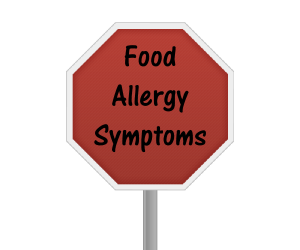Food Allergy Symptoms

Symptoms from exposure to a food allergen usually appear in one or more body systems. Here are many of the most common symptoms:
Abdominal or stomach pain If pain is felt internally, (above the belly button or below the belly button), it is called abdominal pain because it is in the abdominal region behind the abdominal muscles. During an allergic reaction abdominal pain may be a result of swelling and the rejection of the allergen
Dizziness Can be referred to as lightheaded and is the feeling of spinning or whirling.
Fainting A brief and sudden loss of consciousness caused by a variety of functions, some examples – a quick drop in blood pressure, lack of oxygen to organs, difficulty breathing, swelling of airways, or pain.
Hives This condition is also called urticaria. It is described as swollen, pale red, welts or patches of skin. Hives have an itchy, burning, or stinging sensation. Symptoms may occur on skin, in the throat or on the tongue and can vary in size per hive and amount of hives (one or more).
Loss of consciousness A lack of responsiveness similar to deep sleep although returning to consciousness may be difficult, prolonged (coma) or may not occur. Loss of consciousness can occur as a result of anaphylaxis due to symptoms of shock, swelling, rapid change in blood pressure and/or change in heart rate.
Rapid pulse Also called tachycardia or abnormally rapid heart rate; the heart rate beats faster than normal and measured in beats per minute or bpm. Normal heart rates are: Infants 100 to 160 bpm; Ages 1 to 10 – 70 to 120 bpm; Ages 10 and older – 60 to 100 bpm.
Flushing or Redness When the skin takes on a reddish appearance it is considered flushed. A common example is when a person blushes the cheeks become pink or red. During an allergic reaction flushing can occur anywhere on the skin surface after contact or ingestion of an allergen.
Shock When the body is in shock the heart rate beats faster and blood vessels constrict limiting the amount of oxygen in the blood and blood flow to the organs. Loss of consciousness, fainting, dizziness and lower blood pressure can occur. If associated with a severe allergic reaction it is known as anaphylactic shock and is a life threatening symptom.
Swelling During an allergic reaction fluid collects in cells which create a puffy appearance on face, lips, tongue, eyes, skin and/or extremities. Swelling can be internal as well and affect the respiratory system (throat, lungs, and bronchial tubes) or gastrointestinal system (intestines, esophagus, tongue, and throat).
Wheezing When the bronchial tubes swell there is less room for air to travel during inhalation and exhalation. The resulting sound is called wheezing. The sound may resemble a whistle or compressed air.
Vomiting The rejection and ejection of stomach contents through the mouth. During an allergic reaction this can occur repeatedly. Occasionally accompanies increased saliva, weakness, nausea, or pain.
If you suspect you have food allergies, see your doctor or allergist for testing and diagnosis. Knowing what foods to avoid and carrying emergency medicine like epinephrine, if needed, can save your life if you have a serious allergy.
- What are the most common food allergies?
- Food allergy and food intolerance?
- Are food allergies increasing?
- What is anaphylaxis?
- Learn about food allergen labeling
Category: Food
